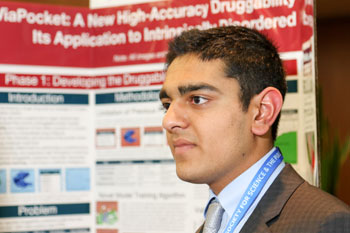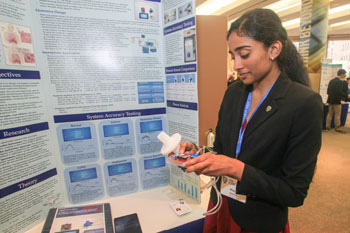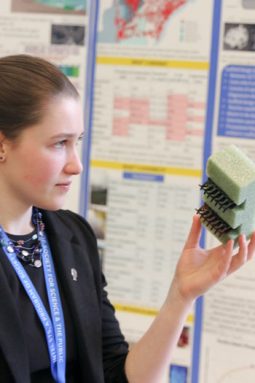Teen scientists win big for health and environmental-cleanup research
Three high school scientists each claim $150,000 awards in the Intel Science Talent Search

The three top winners of the 2016 Intel Science Talent Search. From left: Amol Punjabi, Paige Brown and Maya Varma.
L. Doane/SSP
Share this:
- Share via email (Opens in new window) Email
- Click to share on Facebook (Opens in new window) Facebook
- Click to share on X (Opens in new window) X
- Click to share on Pinterest (Opens in new window) Pinterest
- Click to share on Reddit (Opens in new window) Reddit
- Share to Google Classroom (Opens in new window) Google Classroom
- Click to print (Opens in new window) Print
WASHINGTON, D.C. — When life hands people problems, many try to find a way around them. But this year, the three top winners of the 75th annual Intel Science Talent Search (STS) tackled head on the problems they saw in the world. One designed a way to clean polluted streams. Another developed a way to detect lung problems. A third found new targets for treating cancer.
Until a year ago, Intel only handed out a single top prize of $100,000. This year, they are issuing three prizes of $150,000. The Basic Research prize went to Amol Punjabi. Paige Brown took home the Global Good prize. Maya Varma claimed the Innovation prize.
The winners were announced here during a gala celebration on March 15.
The Science Talent Search was developed in 1942 by Society for Science & the Public. Intel Corp. of Santa Clara, Calif., has sponsored the event since 1998. Each year, the competition brings 40 high school seniors to the nation’s capital to share their research with the public and to compete for big awards. This year those awards are together worth more than $1 million.
Scientific research is “more than being about answers. It’s about the questions,” said Neil deGrasse Tyson. The noted astrophysicist and science communicator is acting director of the Hayden Planetarium in New York City. He also hosts the television series Cosmos: A Spacetime Odyssey. This year, deGrasse Tyson gave the keynote speech at the Intel STS gala. “These 40 finalists give me confidence,” he said.
The finalists are not only talented scientists, they also are well-rounded individuals, said Maya Ajmera. She is president and chief executive officer of Society for Science & the Public. The non-profit organization, based here in Washington, D.C., publishes Science News and Science News for Students. Ajmera has a special connection to the STS competition. Not so long ago, she was a semifinalist herself. Now, to this year’s finalists, she says, “We are betting on you to make the world a better place.”
A program to peg proteins
Amol, 17, of Marlborough, Mass., has always been interested in chemistry and biology. But once he learned how to code, he says “it clicked.” From then on, he knew how he would like to make an impact in the world. A student at the Massachusetts Academy of Math and Science in Worcester, he set out to create computer software to “take all of the data [that] normally people set aside as useless and use it to come up with real results.”

Proteins can have intricate structures. If those structures become disordered, diseases such as cancer may develop. Unfortunately, when proteins go bad, their chaotic sections can change frequently and be hard to pin down. This makes disordered proteins difficult to target with drugs that could shut them down.
Instead of targeting the messy sections of the proteins gone rogue, Amol sought nearby, normal sections of the protein as sites at which to target drugs. His software analyzes the chains of smaller molecules that make up proteins. It searches for short sections near the disordered areas that might contain “pockets” — small dips in the protein shape where a drug could bind. He has already found six new pockets in proteins that play a role in cancer and heart disease. Soon, the teen hopes to put his software on the Internet, where other scientists can use it to find more targets to fight disease.
Taking a deep breath for lung function
Maya, 17, of Cupertino, Calif., found her scientific inspiration close to home. “One of my close friends has really bad asthma,” she explained. Her friend was diagnosed using a spirometer — a device that measures air inhaled into and exhaled out of the lungs. While studying the spirometer, Maya — now a student at Presentation High School in San Jose — realized that getting diagnosed with a lung disease can be very expensive.

She built a device using a few computer chips and a 3-D printed mouthpiece. As someone blows into the mouthpiece, the attached computer chips analyze the volume of air and how quickly it is exhaled. Then the system spits out a diagnosis. A computer program uses the chips’ data to differentiate between five lung disorders — including asthma and chronic obstructive pulmonary disease (in which the lungs lose their ability to take in as much air as before). The program for the spirometer works on smartphones and tablet computers.
Maya has already applied for a patent for her device, which costs only $35 to make. She hopes it will be used in areas where people cannot easily reach a doctor.
Pitching in on polluted streams
Paige, 17, of Bangor, Maine, also found some local motivation. During chemistry class at Bangor High School, the teen had been shocked to find out just how much phosphorus was in local waterways. She thought the streams were pristine. But the phosphorus was a sign that they were polluted with fertilizer. “I couldn’t believe it,” she recalls.
Excess fertilizer in streams can lead to eutrophication — a situation where nutrients boost algal growth. The overgrowth of algae can use up much of the oxygen in the water. Choked off from oxygen, animals that live in the water can suffer or die.

The teen’s filter is a tiny, quarter-size circle that packs a lot of power. It’s made from alginate (AL-jih-NATE), a molecule found in brown seaweed. She mixed it with magnesium and aluminum. When phosphorus in the water bumps into the metals, it binds to them. The metals then precipitate out of the water, becoming a solid that can be removed easily.
Fantastic teen research
Three second-place winners each got cash awards of $75,000. Meena Jagadeesan, 17, of Naperville, N.H., Phillips Exeter Academy, won in the Basic Research category. Michael Zhang, 18, of Berwyn, Pa., Conestoga High School, won in the Global Good category. Milind Jagota, 18, of Bethlehem, Pa., Liberty High School, placed here for Innovation.
Three third-place winners each received cash awards of $35,000. Kunal Shroff, 17, of Great Falls, Va., Thomas Jefferson High School for Science and Technology, won for basic research. Nathan Marshall, 17, of Boise High School in Idaho, took home an award for global good research. And Kavya Ravichandran, 17, of Westlake, Ohio, Hathaway Brown School, won in the innovation category.
Addressing the finalists, Kim Stevenson, the chief information officer at Intel Corp. says, “I want you to continue on your journey” of discovery. These finalists, she says “are pioneers…[and] represent the next generation.”
Power Words
(for more about Power Words, click here)
algae Single-celled organisms, once considered plants (they aren’t). As aquatic organisms, they grow in water. Like green plants, they depend on sunlight to make their food.
alginate A molecule found normally in brown seaweed. It forms a thick gel that can be used to wound healing and to help build new tissues.
aluminum A metallic element, the third most abundant in Earth’s crust. It is light and soft, and used in many items from bicycles to spacecraft.
amino acids Simple molecules that occur naturally in plant and animal tissues and that are the basic constituents of proteins.
asthma A disease affecting the body’s airways, which are the tubes through which animals breathe. Asthma obstructs these airways through swelling, the production of too much mucus or a tightening of the tubes. As a result, the body can expand to breathe in air, but loses the ability to exhale appropriately. The most common cause of asthma is an allergy. It is a leading cause of hospitalization and the top chronic disease responsible for kids missing school.
astrophysics An area of astronomy that deals with understanding the physical nature of stars and other objects in space. People who work in this field are known as astrophysicists.
biology The study of living things. The scientists who study them are known as biologists.
cancer Any of more than 100 different diseases, each characterized by the rapid, uncontrolled growth of abnormal cells. The development and growth of cancers, also known as malignancies, can lead to tumors, pain and death.
cell The smallest structural and functional unit of an organism. Typically too small to see with the naked eye, it consists of watery fluid surrounded by a membrane or wall. Animals are made of anywhere from thousands to trillions of cells, depending on their size.
chemistry The field of science that deals with the composition, structure and properties of substances and how they interact with one another. Chemists use this knowledge to study unfamiliar substances, to reproduce large quantities of useful substances or to design and create new and useful substances. (about compounds) The term is used to refer to the recipe of a compound, the way it’s produced or some of its properties.
chronic A condition, such as an illness (or its symptoms, including pain), that lasts for a long time.
chronic obstructive pulmonary disease A progressive disease where the walls of the lungs are not as flexible as before, making it difficult to take in air. They can also become clogged with mucus, or the air sacs in the lungs can break down.
code (in computing) To use special language to write or revise a program that makes a computer do something.
coding A slang term for developing computer programming — or software — that performs a particular, desired computational task.
computer chip (also integrated circuit) The computer component that processes and stores information.
computer program A set of instructions that a computer uses to perform some analysis or computation. The writing of these instructions is known as computer programming.
developing world A region with relatively little industry and a lower standard of living than industrial countries, such as the United States and Canada.
diagnose To analyze clues or symptoms in the search for their cause. The conclusion usually results in a diagnosis — identification of the causal problem or disease.
eutrophication The process by which a body of water becomes full of nutrients, which then stimulates the excessive growth of plants and algae. When these organisms die, bacteria break them down. But this bacterial activity can temporarily use up much of the water’s dissolved oxygen. Without too little oxygen, animals can suffer — even suffocate. In short order, a eutrophic ecosystem can collapse.
fertilizer Nitrogen, phosphorus and other plant nutrients added to soil, water or foliage to boost crop growth or to replenish nutrients that removed earlier by plant roots or leaves.
filter (in chemistry and environmental science) A device which allows some materials to pass through but not others, based on their size or some other feature. (in physics)A screen, plate or layer of a substance that absorbs light or other radiation or selectively prevents the transmission of some of its components.
innovation (v. to innovate; adj. innovative) An adaptation or improvement to an existing idea, process or product that is new, clever, more effective or more practical.
Intel Science Talent Search An annual competition created and run by Society for Science & the Public and sponsored by Intel Corp. Begun in 1950, this event brings 40 research-oriented high school seniors to Washington, D.C. to showcase their research to the public and to compete for awards.
nutrient A vitamin, mineral, fat, carbohydrate or protein that a plant, animal or other organism requires as part of its food in order to survive.
oxygen A gas that makes up about 21 percent of the atmosphere. All animals and many microorganisms need oxygen to fuel their metabolism.
patent A legal document that gives inventors control over how their inventions — including devices, machines, materials, processes and substances — are made, used and sold for a set period of time. Currently, this is 20 years from the date you first file for the patent. The U.S. government only grants patents to inventions shown to be unique.
phosphate A chemical containing one atom of phosphorus and four atoms of oxygen. It is a component of bones, hard white tooth enamel, and some minerals such as apatite.
phosphorus A highly reactive, nonmetallic element occurring naturally in phosphates. Its scientific symbol is P. It is an important part of many chemicals and structures that are found in cells, such as membranes, and DNA.
precipitation (in chemistry) The creation of a solid from a solution. This can occur if there is too much of a chemical to dissolve completely in a solution. It also can be a sign that some chemical reaction is taking place. (in meteorology) A term for water falling from the sky. It can be in any form, from rain and sleet to snow or hail.
pristine An adjective referring to something that is in original or near-original condition. It means something is somewhat old but in a seemingly “untouched” or unaltered condition.
proteins Compounds made from one or more long chains of amino acids. Proteins are an essential part of all living organisms. They form the basis of living cells, muscle and tissues; they also do the work inside of cells. The hemoglobin in blood and the antibodies that attempt to fight infections are among the better-known, stand-alone proteins.Medicines frequently work by latching onto proteins.
pulmonary An adjective describing things that relate to the lungs or lung function.
smartphone A cell (or mobile) phone that can perform a host of functions, including search for information on the Internet.
Society for Science and the Public (or SSP) A nonprofit organization created in 1921 and based in Washington, D.C. Since its founding, SSP has been not only promoting public engagement in scientific research but also the public understanding of science. It created and continues to run three renowned science competitions: The Intel Science Talent Search (begun in 1942), the Intel International Science and Engineering Fair (initially launched in 1950) and Broadcom MASTERS (created in 2010). SSP also publishes award-winning journalism: in Science News (launched in 1922) and Science News for Students (created in 2003). Those magazines also host a series of blogs (including Eureka! Lab).
software The mathematical instructions that direct a computer’s hardware, including its processor, to perform certain operations.
spirometer A device for measuring the volume of air inhaled and exhaled from the lungs.
technology The application of scientific knowledge for practical purposes, especially in industry — or the devices, processes and systems that result from those efforts.
three-dimensional (3-D) printing The creation of a three-dimensional object with a machine that follows instructions from a computer program. The computer tells the printer where to lay down successive layers of some raw material, which can be plastic, metals, food or even living cells. 3-D printing is also called additive manufacturing.